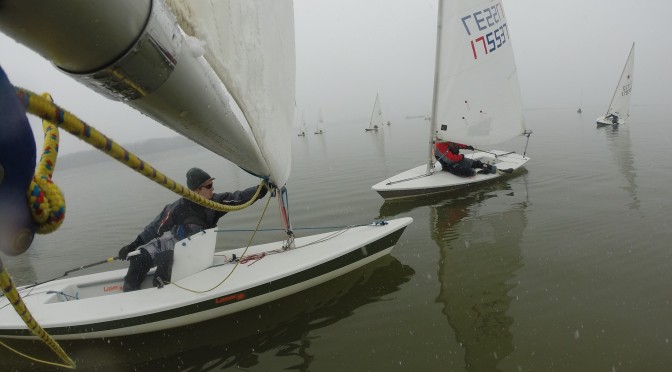Today was a really nice day to be out sailing. Temps were in the upper 30s and lower 40s, sunny, with winds in the 8-12 range getting lighter in the afternoon. You will note I checked the weather and alerts before heading to the marina. This is a critical safety step that cannot be skipped.
In the first race I was slightly late to the line and I got a B+ start with clear air but not at the line on time. The wind was patchy so I kept an eye on where the next wind gust was in the river. I rounded the last leeward mark in about 5th but got lucky with a sustained puff on the right side of the course letting me pass a few boats.
I screwed up the start in the second race and was behind both the first and second row of boats. I worked to get clear air on the right which helped for a time but I had to eat a header that kept me behind the main fleet. I tacked on what I thought was the lay line, forgetting about the current which pushed be below the mark. I lost a few more boats when I added more tacks to get around. Ideally I would stay mid-course to work shifts. Also it’s good to avoid getting to the lay line when in the middle or back of the fleet. Boats in front of you will also tack on the lay line blocking your wind. To avoid this I should have tacked inside the lay line, but I often forget this lesson.
In the third race I got a good start and had clear air near the front of the fleet. The wind was light and patchy so this race was mostly aim for wind and keep momentum. I did okay on this race but I messed up the final leeward rounding. Farley and Michael tacked immediately after the mark where as I held on to port tack for 4-5 boat lengths. The wind had clocked far enough right that no tacking was needed to get to the finish line. Holding on to port cost me exactly 4-5 boat lengths that I wasn’t able to make up.
For the fourth race the wind was mostly gone so the RC (wisely) switched to a once around course. I somehow got an A+ start, which was critical. The light wind clocked to almost west 15 seconds after the start and the race was a parade. I managed to hold my position and finished well. The weather was beautiful and thanks to the RC for running 4 very good races.

